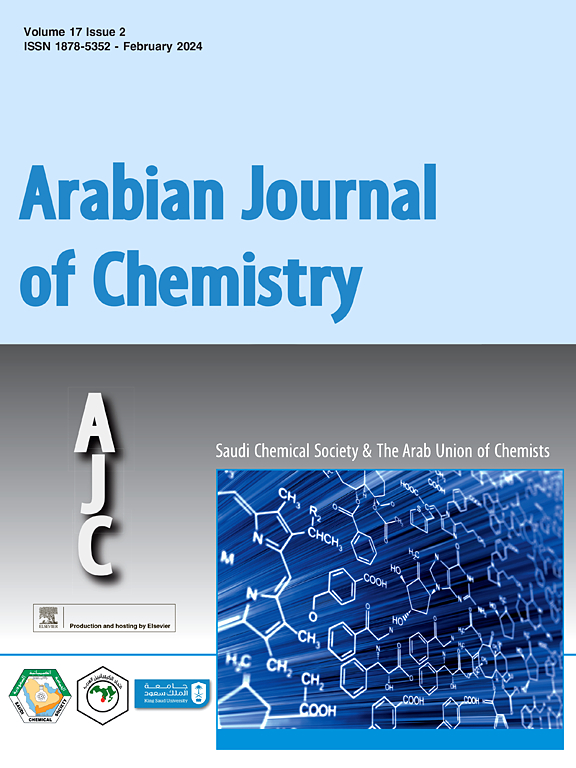Terbium metal–organic frameworks for the efficient removal of tartrazine food dye from aquatic systems: Thermodynamics, kinetics, isotherm, and box-behnken design optimization
IF 5.2
2区 化学
Q2 CHEMISTRY, MULTIDISCIPLINARY
引用次数: 0
Abstract
The elimination and removal of the yellow food coloring tartrazine dye E-102 (TZ) from aqueous solutions was conducted using stacked nanorods made of Terbium metal–organic frameworks (Tb-MOF). The adsorbent was assessed using various methods including FTIR, BET, XRD, XPS, SEM, and TEM. The results showed that the surface area decreased from 1123.07 to 762.8 m2.g−1, the pore volume reduced from 4.02 to 2.6 cc/g, and the pore size decreased from 7.8 to 3.2 nm after adsorption. The reduction in surface area, pore volume, and pore size post-TZ dye adsorption indicates that some of the adsorption mechanisms took place through the pores of the adsorbent. Examined the impact of temperature, pH, initial dye concentration, and contact time on the removal of TZ dye. The adsorption of TZ was found to conform to the Langmuir isotherm and pseudo-second-order kinetic model. The maximum adsorption capacity for TZ was determined to be 817.63 mg/g. The resulting pHzpc value of 5.36 indicates that adsorption of anionic dyes, such as TZ dye, is advantageous at pH levels below 5.36. Moreover, the adsorption process exhibited an adsorption energy of 23.78 kJ/mol, suggesting the presence of a chemisorption mechanism. The thermodynamic parameters calculated indicate that the adsorption processes are both spontaneous and endothermic. It is advisable to utilize the Tb-MOF adsorbent for a total of five cycles, as the adsorbent’s ability to regenerate suggests that treating industrial wastewater can be achieved easily and efficiently. The efficiency of the adsorption process was enhanced through optimization using the Box-Behnken Design (BBD).
铽金属有机框架用于高效去除水生系统中的酒石酸食品染料:热力学、动力学、等温线和箱式优化设计
利用金属有机铽框架(Tb-MOF)制成的叠层纳米棒,对水溶液中的黄色食用色素酒石酸染料 E-102 (TZ) 进行了消除和去除。采用傅立叶变换红外光谱、BET、XRD、XPS、扫描电镜和 TEM 等多种方法对吸附剂进行了评估。结果表明,吸附后表面积从 1123.07 m2.g-1 减小到 762.8 m2.g-1,孔体积从 4.02 cc/g 减小到 2.6 cc/g,孔径从 7.8 nm 减小到 3.2 nm。TZ染料吸附后表面积、孔体积和孔径的减小表明,部分吸附机理是通过吸附剂的孔隙实现的。研究了温度、pH 值、初始染料浓度和接触时间对去除 TZ 染料的影响。发现 TZ 的吸附符合 Langmuir 等温线和伪秒阶动力学模型。TZ 的最大吸附容量为 817.63 mg/g。得出的 pHzpc 值为 5.36,这表明阴离子染料(如 TZ 染料)在 pH 值低于 5.36 时具有吸附优势。此外,吸附过程的吸附能为 23.78 kJ/mol,表明存在化学吸附机制。计算得出的热力学参数表明,吸附过程既是自发的,又是内热的。由于 Tb-MOF 吸附剂具有再生能力,因此建议使用该吸附剂共进行五个循环,这样可以轻松高效地处理工业废水。通过使用方框-贝肯设计(BBD)进行优化,提高了吸附过程的效率。
本文章由计算机程序翻译,如有差异,请以英文原文为准。
求助全文
约1分钟内获得全文
求助全文
来源期刊

Arabian Journal of Chemistry
CHEMISTRY, MULTIDISCIPLINARY-
CiteScore
10.80
自引率
3.30%
发文量
763
审稿时长
63 days
期刊介绍:
The Arabian Journal of Chemistry is an English language, peer-reviewed scholarly publication in the area of chemistry. The Arabian Journal of Chemistry publishes original papers, reviews and short reports on, but not limited to: inorganic, physical, organic, analytical and biochemistry.
The Arabian Journal of Chemistry is issued by the Arab Union of Chemists and is published by King Saud University together with the Saudi Chemical Society in collaboration with Elsevier and is edited by an international group of eminent researchers.
 求助内容:
求助内容: 应助结果提醒方式:
应助结果提醒方式:


